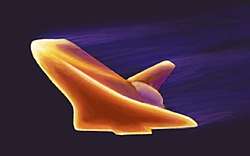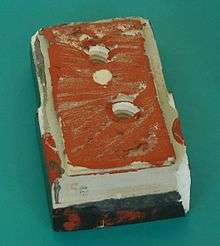LI-900
LI-900 is a type of reusable surface insulation tile developed and manufactured by Lockheed Missiles and Space Company in Sunnyvale, California. It was designed for use on the Space Shuttle orbiter as part of its thermal protection system to minimize thermal conductivity while providing maximum thermal shock resistance.[2]

Statistics
LI-900 has a bulk density of 144.2 kg/m³ (9 lb/ft³). It was for this reason that it was called the LI-900. It is made from 99.9% pure silica glass fibres, and is 94% air by volume. An LI-900 tile can be heated to 1,204 °C (1,477 K; 2,199 °F) and then immediately plunged into cold water and suffer no damage.[2]
Black and white tiles were used on the Space Shuttle to control the temperature of the vehicle while in orbit.
- White tiles (known as LRSI) were used mainly on the upper surface and have higher thermal reflectivity. These are therefore pointed towards the sun in order to minimize solar gain.
- Black tiles (known as HRSI) are optimized for maximum emissivity, which means they lose heat faster than white tiles. This property is required in order to maximise heat rejection during re-entry.
There are typically 20,000 HRSI LI-900 tiles on a Space Shuttle, and 725 LRSI LI-900 tiles.
Problems

Strength
As a result of optimizing its thermal properties, overall strength was reduced. The tile was therefore not suitable to be used in high-stress areas such as around the landing gear doors and windows. To solve this, a higher strength version of the LI-900 material was produced, with a bulk density of 352.4 kg/m³ (22 lbs/ft³), which was called the LI-2200.[2] This tile provided the strength and insulating properties, but with a considerable weight penalty.
Damage reduction
A research and development program was started to establish a means for substantially improving the damage resistance and micrometeorite orbital debris (MMOD) characteristics of the LI-900 shuttle baseline tile. This would result in a greatly reduced amount of damage and therefore less repair between flights.
A short term solution was found by developing a new surface treatment for the tile, which took advantage of the Ames technology previously developed, and designated TUFI. A prototype of this material was produced successfully, its damage resistance was determined, and its microstructural stability was demonstrated.
A longer term solution used AETB-8 as the insulation substrate. This substrate is significantly stronger than the LI-900 substrate, and is more compatible with the TUFI surface treatment.
See also
- Space Shuttle thermal protection system
- Atmospheric reentry
References
- "Space Shuttle Orbiter Systems,". NASA. 2000. Retrieved 2009-12-06.
- "Orbiter Thermal Protection System, Thermal Materials" (PDF). NASA. 2006. p. 3. Retrieved 2008-06-05.